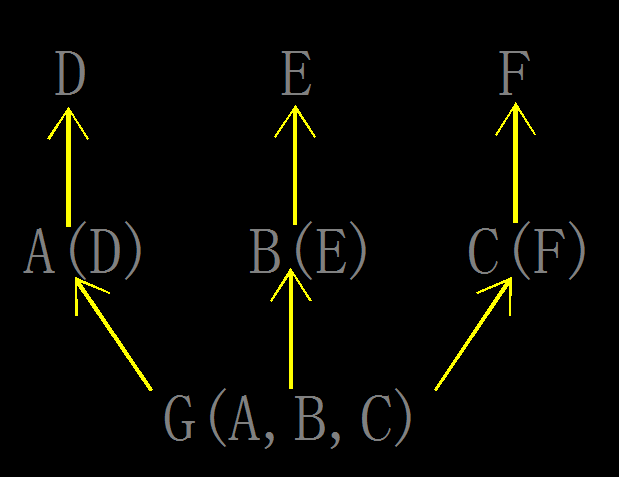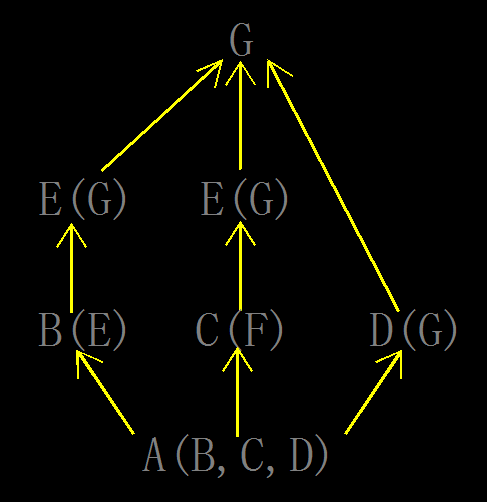一、继承与派生
什么是继承
继承一种新建类的方式,新建的类称为子类或者派生类,被继承的类称为父类或基类或超类
子类会遗传父类的一系列属性
python支持多继承
注意:
在python3中,如果没有显式地继承任何类,那默认继承object类
在python2中,如果没有显式地继承任何类,也不会继承object类
在python中类分为两种:
python3新式类,广度优先
但凡继承object的类,以及该类的子类都是新式类
在python3中所有的类都是新式类
python2经典类,深度优先
没有继承object类,以该类的子类都是经典类
只有在python2中才存在经典类,为何?
因为在python2中没有没有显式地继承任何类,也不会继承object类
1)继承的示例

class Parent1(object): pass class Parent2(object): pass class Sub1(Parent1): pass class Sub2(Parent1,Parent2): pass # __bases__ 打印继承关系,没有继承,默认继承object print(Parent1.__bases__) print(Parent2.__bases__) print(Sub1.__bases__) print(Sub2.__bases__)
2)基于继承减少代码冗余的案例+派生/衍生

import pickle class OldboyPeople: school = 'oldboy' def __init__(self,name,age,sex): self.name=name self.age=age self.sex=sex def save(self): with open('%s' % self.name, 'wb') as f: pickle.dump(self, f) class OldboyStudent(OldboyPeople): def choose_course(self,course): print('%s is choosing course:%s' %(self.name,course)) class OldboyTeacher(OldboyPeople): def __init__(self,name,age,sex,level): # self.name = name # self.age = age # self.sex = sex OldboyPeople.__init__(self,name,age,sex) self.level=level def score(self,stu): print('%s is score %s' %(self.name,stu.name)) # stu1=OldboyStudent('alex',38,'male') # print(stu1.__dict__) # stu1.save() tea1=OldboyTeacher('egon',18,'male',10) print(tea1.name,tea1.level) # tea1.save() # print(stu1.school) # 在子类派生出的新方法中重用父类的功能: #方式一:指名道姓地访问某一个类的函数,与继承是没有关系的 # OldboyPeople.__init__(self,name,age,sex)
3)单继承的属性查找“:对象自己-》对象的类-》父类-》父类

class Foo: def f1(self): print('Foo.f1') def f2(self): #self=obj print('Foo.f2') self.f1() #obj.f1() class Bar(Foo): def f1(self): print('Bar.f1') obj=Bar() obj.f2() # 执行父类的 f2 代码,发现到了f1 ,仍然先从自己这里开始找
4)(python2和python3一样的)多继承的属性查找“:对象自己-》对象的类-》从左往右一个一个的分支找下去


class D: # def test(self): # print('D') pass class E: def test(self): print('E') class F: def test(self): print('F') class A(D): # def test(self): # print('A') pass class B(E): # def test(self): # print('B') pass class C(F): def test(self): print('C') class G(A,B,C): # def test(self): # print('G') pass obj=G() obj.test()
5)python3新式类,广度优先查找,从左到右依次查找。但不先找头,最后才头
print(F.mro()) 方法属性查找顺序
python2经典类,深度优先查找,从左到右依次查找,遇到了头,就找头,再找其他的


# 新式类:广度优先 class A(object): def test(self): print('from A') class B(A): # def test(self): # print('from B') pass class C(A): # def test(self): # print('from C') pass class D(B): # def test(self): # print('from D') pass class E(C): # def test(self): # print('from E') pass class F(D,E):
6)在子类派生出的新方法中重用父类的功能
#方式一:指名道姓地访问某一个类的函数,与继承是没有关系的
# OldboyPeople.__init__(self,name,age,sex)
#方式二:super(自己的类名,self).父类中的方法名()
# 调用super会得到一个特殊的对象,该对象是专门用来引用父类中的方法的,
#具体的:该对象会严格按照当前类的MRO列表从当前类的父类中依次查找属性,即这种方式是严格依赖于继承的
#ps:在python3中可以简写为super()
# !!!!!强调:二者使用哪一种都可以,但最好不要混合使用 !!!!
基于2种方式的实现继承父类方法

class OldboyPeople: def __init__(self,name,age,sex): self.name=name self.age=age self.sex=sex class OldboyTeacher(OldboyPeople): def __init__(self,name,age,sex,level): # OldboyPeople.__init__(self,name,age,sex) # 方式一,访问的函数 super(OldboyTeacher,self).__init__(name,age,sex) # 方式二,访问的方法 self.level=level tea1=OldboyTeacher('egon',18,'male',10) print(tea1.name,tea1.level)
super的应用,无论super定义在哪个位置的方法,都应该当前位置开始查找,查找顺序可以用 mro进行查看

class A: def f1(self): print('A') super().f2() # super()会基于当前所在的查找位置继续往后查找 def f2(self): print('A') class B: def f2(self): print('B') class C(A,B): def f2(self): print('C') obj=C() print(C.mro()) obj.f1()
总结:最好不要用多继承
二、类与类的组合
1)不要组合之前

import pickle class OldboyPeople: school = 'oldboy' def __init__(self,name,age,sex): self.name=name self.age=age self.sex=sex def save(self): with open('%s' % self.name, 'wb') as f: pickle.dump(self, f) class OldboyStudent(OldboyPeople): def __init__(self,name,age,sex): OldboyPeople.__init__(self,name,age,sex) self.courses=[] def choose_course(self,course): print('%s is choosing course:%s' %(self.name,course)) stu1=OldboyStudent('李三泡',18,'male') # print(stu1.courses) stu1.courses.append({'name':'python','price':8000,'period':'5mons'}) stu1.courses.append({'name':'linux','price':10000,'period':'3mons'}) print(stu1.courses) for course in stu1.courses: print(""" 课程名:%s 价钱:%s 周期:%s """ %(course['name'],course['price'],course['period'])) stu2=OldboyStudent('李二泡',38,'female') stu2.courses.append({'name':'python','price':8000,'period':'5mons'}) for course in stu2.courses: print(""" 课程名:%s 价钱:%s 周期:%s """ %(course['name'],course['price'],course['period']))
2)组合的使用意义
1、什么是组合 对象的属性的值是来自于另外一个类的对象,这就叫类的组合使用 2、为何要用组合 组合是用来减少类与类代码冗余的 组合vs继承 只有在类与类之间有从属的关系的时候才能用继承 否则的话用组合
使用组合之后,代码调整

import pickle class OldboyPeople: school = 'oldboy' def __init__(self,name,age,sex): self.name=name self.age=age self.sex=sex def save(self): with open('%s' % self.name, 'wb') as f: pickle.dump(self, f) class OldboyStudent(OldboyPeople): def __init__(self,name,age,sex): OldboyPeople.__init__(self,name,age,sex) self.courses=[] def choose_course(self,course): print('%s is choosing course:%s' %(self.name,course)) def tell_courses_info(self): for course in self.courses: course.tell_info() class Course: def __init__(self,name,price,period): self.name=name self.price=price self.period=period def tell_info(self): print(""" 课程名:%s 价钱:%s 周期:%s """ % (self.name, self.price, self.period)) python=Course('python',8000,'5mons') linux=Course('linux',10000,'3mons') stu1=OldboyStudent('李三泡',18,'male') stu1.courses.append(python) stu1.courses.append(linux) stu2=OldboyStudent('李二泡',38,'female') stu2.courses.append(python) stu1.tell_courses_info() stu2.tell_courses_info()
三、多态与多态性
1、什么是多态 同一种事物的多种形态 2、为何要用多态 多态性:指的是可以在不用考虑对象具体类型的前提下,直接调用对象的方法
1)多态方法,类似的事物用同样的方法

class Animal: def talk(self): pass class People(Animal): def talk(self): print('say hello') class Dog(Animal): def talk(self): print('汪汪汪') class Pig(Animal): def talk(self): print('哼哼哼') peo1=People() dog1=Dog() pig1=Pig() #多态性: peo1.talk() dog1.talk() pig1.talk()
2)函性质的数多态方法

#多态 class People(): def talk(self): print('say hello') class Dog(): def talk(self): print('汪汪汪') class Pig(): def talk(self): print('哼哼哼') peo1=People() dog1=Dog() pig1=Pig() #多态性: def talk(animal): animal.talk() talk(peo1) talk(dog1) talk(pig1)
3)平时统计自动的长度,使用的多态方法

l=list([1,2,3]) s=str('hello') t=tuple((4,5,6)) l.__len__() s.__len__() t.__len__() def len(obj): return obj.__len__() print(len(l)) print(len(s)) print(len(t))
4)强制让子类使用多态属性,import abc

import abc class Animal(metaclass=abc.ABCMeta): # 父类存在的意义就是用来定义规范...# 抽象基类不能被实例化 @abc.abstractmethod def talk(self): pass class People(Animal): def talk(self): print('say hello') class Dog(Animal): def talk(self): print('汪汪汪') class Pig(Animal): def talk(self): print('哼哼哼') peo1=People() dog1=Dog() pig1=Pig() peo1.talk() dog1.talk() pig1.talk()
四、封装
1、什么是封装 “装”的意思就往一个容器中放入一系列属性 “封”的意思就是藏起来,在内部可以看到,但对外部是隐藏的 2、如何用封装 但凡是双下划线开头(不能是双下划线结尾)的属性,会被隐藏起来,类内部可以直接使用 而类外部无法直接使用,即封装是对外不对内的 这种隐藏的特点: 1、只是一种语法上的变形,会将__开头的属性变形为:_自己的类名__属性名 2、该变形只在类定义阶段发生一次,在类定义阶段之后新增的__开头的属性并不会发生变形 3、隐藏是对外不对内的 4、在继承中,父类如果不想让子类覆盖自己的同名方法,可以将方法定义为私有的
1)访问封装起来的隐藏内容

class Foo: __n=1 #_Foo__n=1 def __init__(self,name): self.__name=name #self._Foo__name=name def __f1(self): #_Foo__f1 print('f1') # __n 和 __f1() 被隐藏起来,无法直接被访问 print(Foo.__dict__) # 查看名称空间,可知道如何被访问 print(Foo._Foo__n) print(Foo._Foo__f1)
2)封装的真正使用意义,内部开辟了一个接口来访问隐藏空间
案例一

class Foo: __n=1 #_Foo__n=1 def __init__(self,name): self.__name=name #self._Foo__name=name def __f1(self): #_Foo__f1 print('f1') def f2(self): self.__f1() #self._Foo__f1() print(self.__name) #self._Foo__name print(self.__n) #self._Foo__n obj=Foo('egon') obj.f2()
案例二

class People: def __init__(self,name,age): self.__name=name self.__age=age def tell_info(self): print('<%s:%s>' %(self.__name,self.__age)) def set_info(self,name,age): ''' 修改名字,年龄 :param name: :param age: :return: ''' if type(name) is not str: raise TypeError('用户名必须是str类型') if type(age) is not int: raise TypeError('年龄必须是int类型') self.__name=name self.__age=age p=People('egon',18) p.tell_info() p.set_info('egon',22) p.tell_info()
3)封装的意图
1、封装数据属性:将数据数据隐藏起来,从而类的使用者无法直接操作该数据属性 需要类的设计者在类内部开辟接口,让类的使用者同接口来间接地操作数据, 类的设计者可以在接口之上附加任意逻辑,从而严格控制类的使用者对属性的操作 2、封装函数属性:隔离复杂度

class ATM: def __card(self): print('插卡') def __auth(self): print('用户认证') def __input(self): print('输入取款金额') def __print_bill(self): print('打印账单') def __take_money(self): print('取款') def withdraw(self): self.__card() self.__auth() self.__input() self.__print_bill() self.__take_money() a=ATM() a.withdraw()
五、特性(property)
1)类方法,把一个函数伪造成对象的特殊

class People: def __init__(self,name,height,weight): self.name=name self.height=height self.weight=weight @property def bmi(self): return self.weight / (self.height ** 2) # 封装内置函数 property 用法,本该执行函数的用法是 bmi() 变成了 bmi egon=People('egon',1.80,75) print(egon.bmi)
2)类方法中 property与setter和deleter的使用
先有 proerty伪装函数,才能有setter修改功能,和删除功能

class People: def __init__(self,name): self.__name = name @property # 伪装方法成属性 def name(self): return self.__name @name.setter # 修改方法的属性 def name(self,val): # print('=====>准备修改名字的值:',val) if type(val) is not str: raise TypeError('名字的值必须为str类型') self.__name=val @name.deleter def name(self): # del self.__name print('删不得') p = People('egon') print(p.name) p.name = 'alex' print(p.name) del p.name
六、绑定方法与非绑定办法
1)绑定方法
绑定方法:
特点:
绑定给谁,就应该由谁来调用,谁来调用就会将谁当做第一个参数传入
绑定到对象的方法:
在类中定义的函数,在没有被任何装饰器装饰的情况下,默认都是绑定给对象的
绑定到类的方法
在类中定义的函数,在被装饰器classmethod装饰的情况下,该方法是绑定类的
1)绑定方法使用示例

class Foo: @classmethod def f1(cls): #cls=Foo print('自动传入的是类:',cls) def f2(self): print('自动传入的是对象:',self) print(Foo.f1) print(Foo.f2) print(Foo) Foo.f1()
2)绑定类方法常用示例
配置文件中获取ip和端口连接

HOST='127.0.0.1' PORT=3306
类方法使用

import settings class MySQL: def __init__(self,host,port): self.host = host self.port = port @classmethod def from_conf(cls): return cls(settings.HOST, settings.PORT) conn=MySQL.from_conf() # 利用类方法,从配置文件获取到的连接 print(conn.host,conn.port) conn1=MySQL('1.1.1.1',3306) # 传值获取的连接 print(conn.host,conn.port)
3)非绑定办法。既不与类绑定也不与对象绑定,没有任何自动传值的效果,因为函数体根本也不需要
示例:

import settings import hashlib import time class MySQL: def __init__(self,host,port): self.host=host self.port=port @classmethod def from_conf(cls): return cls(settings.HOST,settings.PORT) @staticmethod def create_id(): m=hashlib.md5() m.update(str(time.clock()).encode('utf-8')) return m.hexdigest() obj=MySQL('1.1.1.1',3306) print(MySQL.create_id()) print(obj.create_id())
七、类的内置函数
1)isinstance和issubclass。判断是否是它的类

class Foo: pass obj=Foo() print(isinstance(obj,Foo)) print(isinstance([],list)) print(type(obj) is Foo) print(type([1,2]) is list) print(issubclass(Foo,object))
2)字符串的改造方法:hasattr和getattr和setattr和delattr
hasattr # 判断字符串是否在类里面的方法
getattr # 找到类里面的字符串
setattr # 新增一个属性
delattr # 删除属性
1)使用示例

class People: country='China' def __init__(self,name): self.name=name #涉及四个内置函数 # hasattr # 判断字符串是否在类里面的方法 print('country' in People.__dict__) print(hasattr(People,'country')) # getattr # 找到类里面的字符串 print(People.__dict__['country']) print(getattr(People,'country')) print(getattr(People,'country1111',None)) # 找不到,也不报错 # setattr # 新增一个属性 setattr(People,'x',111) print(People.__dict__) print(getattr(People,'x')) # delattr # 删除属性 delattr(People,'country') print(getattr(People,'country',None))
2)利用字符串的改造方法输入执行相应的技能

class Ftp: def get(self): print('get...') def put(self): print('put...') def auth(self): print('auth...') def run(self): while True: cmd=input('>>: ').strip() #cmd='get' if hasattr(self,cmd): method=getattr(self,cmd) method() else: print('输入的方法不存在') obj=Ftp() obj.run()
八、类的内置方法
1)__str__,用在类中,实印例化对象后,自动触发,返回值必须是字符串格式的类型

class People: def __init__(self,name,age,sex): self.name=name self.age=age self.sex=sex # 该方法会在对象被打印时自动触发, def __str__(self): # print('=====run=====') return '["%s",%s,"%s"]' %(self.name,self.age,self.sex) obj=People('egon',18,'male') print(obj) # print(obj.__str__())
2)__del__,会在对象被删除前自动触发。适用于回收机制。

# 伪代码, # 因connect连接涉及到了2方面的资源。所有需要在程序结束时,自动触发回收机制 class Mysql: def __init__(self,host,port): self.host=host self.port=port self.conn=connect(host,port) def __del__(self): self.conn.close() obj=Mysql('1.1.1.1',3306)
3)__call__,调用对象的时候触发
class Foo: def __init__(self): # 对象实例化的时候触发 pass def __str__(self): # 打印对象的时候触发 pass def __del__(self): # 删除对象的时候触发 pass def __call__(self, *args, **kwargs): # 调用对象的时候触发 print("__call__") obj = Foo() obj() # 自动触发 __call__ 这个方法
九、元类方法(了解)
1)exec的使用。把字符串产生的名字丢在名称空间里面

code=""" x=0 y=2 """ local_dic={} exec(code,{},local_dic) # 第二个放全局的名称空间。第三个局部的名称空间 print(local_dic)
exec的作用:自己定义全局名称空间的名字和局部名称空间的名字。函数也可以

code=""" global x x=0 y=2 def f1(self,a,b): pass """ global_dic = {"x":100} local_dic={} exec(code,global_dic,local_dic) # 第二个放全局的名称空间。第三个局部的名称空间 print(global_dic) print(local_dic)
2)对象的产生过程

class Chinese: country="China" def __init__(self,name,age,sex): self.name=name self.age=age self.sex=sex def speak(self): print('%s speak Chinese' %self.name) print(Chinese) print(type(Chinese)) # 元类:类的类就是元类, p=Chinese('egon',18,'male') print(type(p)) # 我们用class定义的类使用来产生我们自己的对象的 # 内置元类type是用来专门产生class定义的类的 # 相当于 type 实例化 class,class 再实例化成对象
3)exec 方法 创建类(class)的第二种方式,也是类创建的原理

class_name='Chinese' class_bases=(object,) class_body=""" country="China" def __init__(self,name,age,sex): self.name=name self.age=age self.sex=sex def speak(self): print('%s speak Chinese' %self.name) """ class_dic={} exec(class_body,{},class_dic) # 类的三大要素 print(class_name,class_bases,class_dic) Chinese=type(class_name,class_bases,class_dic) print(Chinese) p=Chinese('egon',18,'male') print(p.name,p.age,p.sex)
4)自定义类的创建规范

class Mymeta(type): def __init__(self,class_name,class_bases,class_dic): if not class_name.istitle(): raise TypeError('类名的首字母必须大写') if not class_dic.get('__doc__'): raise TypeError('类中必须写好文档注释') super(Mymeta, self).__init__(class_name, class_bases, class_dic) # 重用父类的功能 # 类 Foo的首字母必须大写,必须有注释。 class Foo(object,metaclass=Mymeta): ''' 管理员类 ''' pass
5)自定义控制类的调用

class Mymeta(type): # 控制类的Foo的创建 def __init__(self,class_name,class_bases,class_dic): if not class_name.istitle(): raise TypeError('类名的首字母必须大写') if not class_dic.get('__doc__'): raise TypeError('类中必须写好文档注释') super(Mymeta, self).__init__(class_name, class_bases, class_dic) # 重用父类的功能 # 控制类Foo的调用,即控制实例化Foo的过程 def __call__(self, *args, **kwargs): obj = object.__new__(self) self.__init__(obj, *args, **kwargs) return obj class Foo(object,metaclass=Mymeta): """ 文档注释 """ x=1 def __init__(self,y): self.y=y def f1(self): print('from f1') obj=Foo(1111) #Foo.__call__() print(obj.y) print(obj.__dict__)
6)单实例模式。共用资源,不重复创建

import settings class MySQL: __instance=None def __init__(self,ip,port): self.ip=ip self.port=port @classmethod def singleton(cls): if not cls.__instance: obj=cls(settings.IP, settings.PORT) cls.__instance=obj return cls.__instance obj1=MySQL('1.1.1.2',3306) obj2=MySQL('1.1.1.3',3307) obj3=MySQL('1.1.1.4',3308) # 单实例模式,ip和端口也一样 obj4=MySQL.singleton() obj5=MySQL.singleton() obj6=MySQL.singleton() print(obj4 is obj5 is obj6)
原文链接:
http://www.cnblogs.com/linhaifeng/articles/7340153.html
http://www.cnblogs.com/linhaifeng/articles/6204014.html




 浙公网安备 33010602011771号
浙公网安备 33010602011771号